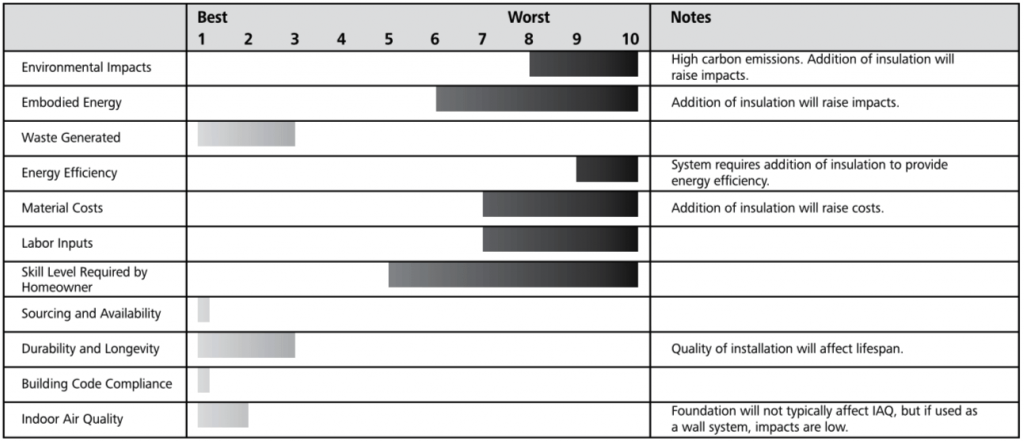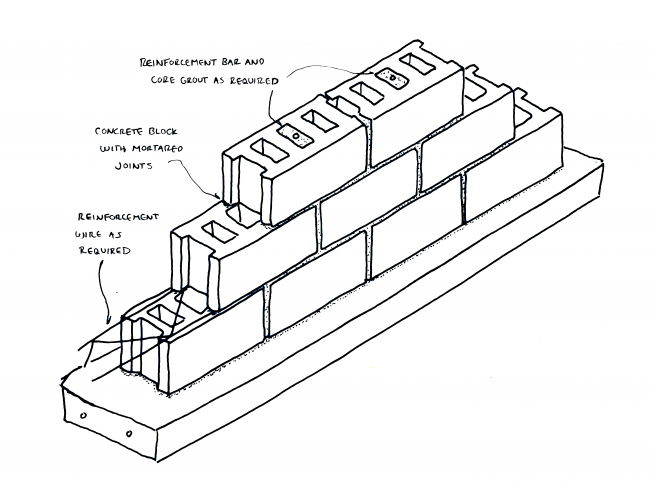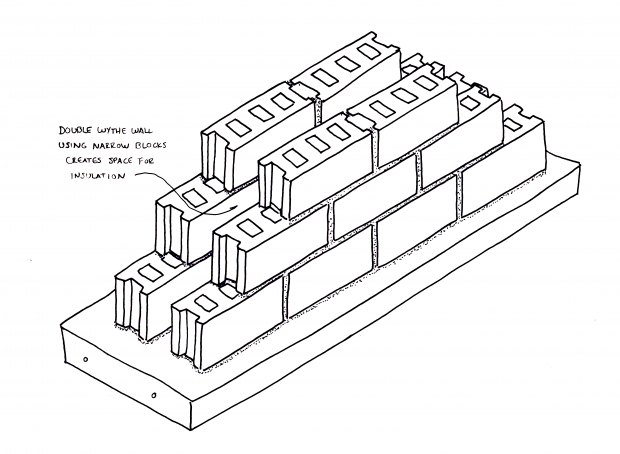concrete Masonry Units (CMU)
FOUNDATIONS: MATERIALS ENCYcLOPEDIA
Applications for this system
Perimeter Beams
Piers
Basic materials
Portland cement
Aggregate
Lightweight aggregates, including expanded shale, expanded clay and expanded recycled glass
Alternative binders, including fly ash and blast furnace slag
Mortar
Ratings Chart for CMU Foundation

The ratings chart shows comparative performance in each criteria category. Click on the tabs below for detailed analysis of each criteria.
- HOW THE SYSTEM WORKS
- ENVIRONMENTAL IMPACTS
- WASTE
- EMBODIED CARBON
- ENERGY EFFICIENCY
- MATERIAL COSTS
- LABOUR INPUT
- SKILL LEVEL REQUIRED
- SOURCING & AVAILABILITY
- DURABILITY
- CODE COMPLIANCE
- INDOOR AIR QUALITY
- RESOURCES
- FUTURE DEVELOPMENT
CMU System

Lightweight CMUs are visually similar to typical heavy- or medium-weight blocks, but are typically 30–40 percent lighter for the same size block. The lower weight is achieved by using lightweight aggregates in place of standard sand and gravel. These aggregates are still mineral-based, but are expanded through the use of heat.
Concrete blocks are precast off-site and brought to the building site cured. Each block has one to three hollow cores, depending on block size and style. Individual blocks are laid up end to end in courses, with the blocks staggered on each course so a full block on each course spans the joint between blocks on the previous course. All joints are mortared.
Once fully built, rebar and a concrete grout are poured into a select number of the hollow cores. These concrete columns add strength to the mortar joints between the blocks.
For basement walls, the finished block is typically parged using a lime-cement mortar to help seal the joints from water penetration. Other waterproofing membranes or sealants may be applied over the parging.
Environmental Impact Rating
Harvesting — Moderate to High
Limestone and aggregate are mechanically extracted from quarries and can have moderate to high impacts on habitat destruction and ground and surface water contamination and flow.
Steel for reinforcement is a high-impact resource to extract.
Manufacturing — High
The creation of portland cement is a high-intensity process, with limestone being heated in kilns to very high sustained temperatures. Fuels used include natural gas, oil, coal, landfill waste and coal, in large quantities, with impacts including significant air pollution and very significant greenhouse gas emissions.
Aggregate is produced in mechanical crushers with relatively low impacts.
Lightweight aggregate is produced under high-heat conditions, with similar impacts to portland cement except for lower greenhouse gas emissions.
Steel for reinforcement is a very high-impact material to manufacture.
Transportation — Low to High
Sample foundation uses 22,863 – 34,013 kg of block, concrete and mortar
21.5 – 32 MJ per km by 35 ton truck
Cement and aggregate are heavy, high-volume materials and impacts will rise proportionally with distance traveled, both in production and site delivery.
Installation — Negligible to Moderate
Leftover block can be used elsewhere; leftover mortar must be disposed.
Waste: low to medium
Biodegradable/Compostable — CMU offcuts
Recyclable — Metal reinforcement bar
Landfill — Mortar bags
Chart of Embodied energy & carbon
Energy Efficiency: Very Low
The aggregate used in lightweight CMUs gives the blocks a slightly higher thermal resistance than standard concrete blocks or poured concrete. However, this higher R-value does not translate into meaningful cold climate performance and a similar amount of additional insulation will be required as with any foundation to create a properly energy-efficient foundation.
One advantage of CMUs is the ability to affordably build double-wythe foundation walls, which can be particularly advantageous when supporting wider wall systems. When using two walls of narrow CMU, a builder can insulate the gap between the walls, rather than adding insulation to the interior and/or exterior. This can help create a continuous insulation layer from the foundation up through the wall, and can allow a builder to choose from a wider range of insulations.
Material costs: High
Lightweight CMU is less common than the heavyweight version and often costs more per block. The combination of poured footing, reinforcing bar, mortar and block adds up to a significant amount of material, leading to fairly high costs.
Labour Input: High
CMU foundations require a similar amount of labor as poured concrete foundations. As no formwork is required (except to pour a footing at the base of the wall), this labor-intensive element is skipped. The movement of blocks and mortar on-site represents the highest amount of labor for a block project, and can be handled by unskilled labor. Typically, a single laborer serves a single block layer.
Skill level required for homeowners: moderate to difficult
CMU foundations require a similar amount of labor as poured concrete foundations. As no formwork is required (except to pour a footing at the base of the wall), this labor-intensive element is skipped. The movement of blocks and mortar on-site represents the highest amount of labor for a block project, and can be handled by unskilled labor. Typically, a single laborer serves a single block layer.
Sourcing & availability: Easy
Lightweight CMUs are available from most masonry supply outlets, but are not as common as heavy- and medium-weight blocks. It may be necessary to special order the light blocks.
Durability: High to Very High
A well-built block foundation with an appropriate number of reinforced, grouted cores will be a long-lasting foundation, capable of a century or more of service. The quality of the mortar joints will affect durability.
Code compliance
Lightweight CMU foundations are an accepted solution in most jurisdictions and if designed to code specifications should face no hurdles for permitting.
Indoor air quality: n/a
Lightweight CMUs will have little direct impact on indoor air quality. By keeping the floors and walls of the building dry they can help to prevent other IAQ issues.
Resources for further research
The Complete Guide to Masonry and Stonework: Includes Decorative Concrete Treatments. Chanhassen, MN: Creative, 2006. Print.
Future development
Standards for block sizing and installation are well developed and unlikely to change significantly.
Lightweight CMUs are gaining wider acceptance in the masonry industry. Some producers are using recycled glass aggregate, and many are using portland cement replacements like fly ash and blast furnace slag in their blocks. The development of very lightweight blocks would lower environmental impacts and increase thermal performance.
CMUs will benefit from any advances made in the “greening” of cement materials and production.
Tips for a successful CMU foundation
CMU foundations are a very conventional approach and as such the information required to successfully build with them is widely available and is not detailed here.




